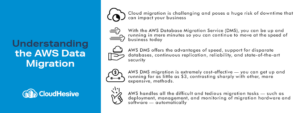AWS Data Migration Service takes the headaches out of moving to the cloud
When moving to the cloud, data migration is the biggest challenge. They are always more complicated than they initially appear, and a messy or failed migration means business downtime in an era when speed is of the essence. Fortunately, Amazon Web Services (AWS) provides an array of data transfer services for every data migration project.
Using the AWS Database Migration Service (AWS DMS) means your source database is fully operational during migration to minimize downtime and keep your business going. In addition, AWS DMS can migrate your data both to and from most databases, whether commercial or open-source. There’s also support for homogenous migrations and those from different database platforms, so you can continuously replicate data with low latency from any source to any target that’s supported.
The addition of AWS DMS Fleet Advisor helps automate migration planning while aiding migration of your database and analytics fleets at scale easily. Let’s take a look at the benefits of AWS DMS and just how it works.
AWS Database Migration Service benefits
Figuring out what you want to migrate to the cloud and when is difficult enough without complicated migration tools. With AWS DMS, there are no drivers or apps to install, and your database migration begins with just a few clicks in the AWS Management Console. Once you’ve begun your migration, DMS takes care of the complex work, including automatic replication of any changes in data that occur in your source database while the migration is happening. In addition, with AWS DMS, there is:
- Virtually no downtime: All data changes in your source data are continuously replicated, which means you can continue to use your source database. When migration is complete, the target cloud database stays synchronized to the source for as long as you wish, so you can switch over to the cloud database when it’s convenient for your business.
- Support for widely-used databases: Whether they’re commercial or open-source, migration is supported for both homogeneous databases and disparate ones. Data also can be moved between targets such as SQL, NoSQL, as well as text-based.
- Continuous replication: This ongoing replication means source changes are applied to the cloud database with very short latency for as long as you desire. DMS also features data validation and transformations for all replication tasks.
- Reliability. The AWS Database Migration Service monitors your source and target databases, your network connectivity, and replication instances. If there is an interruption, DMS restarts the process automatically and continues the migration from where it was interrupted.
Security is paramount, of course. AWS DMS uses Secure Sockets Layer (SSL) for your endpoint connections with Transport Layer Security (TLS). AWS Key Management Service encrypts the storage used by your replication instance as well as its endpoint connection information. These keys are also used to secure your target data at rest for Amazon S3 and Amazon Redshift endpoints.
Another big benefit of AWS DMS is the cost. You pay only for the resources used during your migration and additional log storage, if any. Have a terabyte-sized database? You can migrate it to the AWS cloud for a cost as low as $3, in contrast to expensive and less reliable data migration systems. AWS DMS also has a data transfer services portfolio that offers a variety of solutions to match any data transfer project.
How AWS Data Migration Service solutions work
Data migration sounds simple – moving data from one endpoint to another— but it can be quite challenging. With AWS Data Migration Service, you can migrate between two sources that use the same database engine or different ones with the only requirement being that one of your endpoints must be on an AWS service to use AWS DMS.
The AWS DMS replication process works as follows:
Source Database ⇒ Source Endpoint ⇒ Replication Instance ⇒ Endpoint Target ⇒ Target Database
Because AWS DMS manages the deployment, management, and monitoring of migration hardware and software automatically, your migration can be up and running in mere minutes after beginning the configuration process. These are just a few of the tedious and difficult jobs AWS DMS takes over to ensure a seamless, secure migration.
AWS DMS connects to your source data store, reads it, and then formats it so it can be used by the target datastore before loading it. When using AWS DMS, you create a replication server, source, and target endpoints with connection information and one or more migration tasks. Migration tasks usually have three phases that include loading all data, applying cached changes, and then ongoing replication.
Amazon offers a number of online data transfer services, including AWS DataSync, AWS Transfer Family, and Amazon Kinesis Date Firehose. With AWS DMS, you can build a migration plan in hours with Amazon Fleet Advisor, as well as save money in planning and migrating, with minimal effort.
CloudHesive: The AWS Data Migration Service experts
We’re a cloud solutions consulting and managed service provider with expertise in AWS cloud migration. We have eight AWS Competencies, more than 50 AWS Certifications, membership in nine Partner Programs, and the experience and knowledge to help your business realize all the benefits of AWS cloud.
We’ve helped more than 100 companies reduce their operating costs and increase productivity with our focus on security, reliability, availability, and scalability. With over 30 years of experience, we leverage cloud-based technology to its full potential. Contact the CloudHesive team today.



